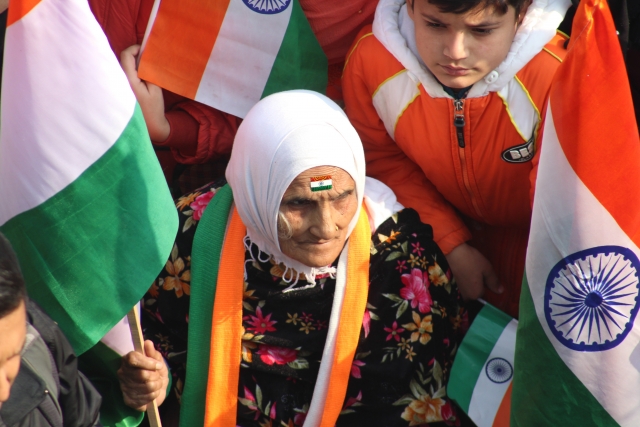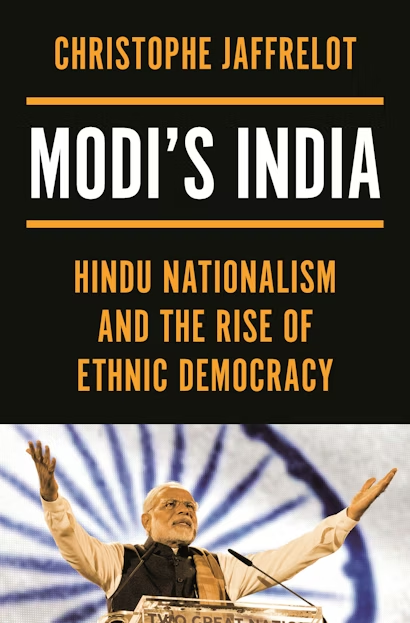The comparative study of democracies has long since determined that this type of regime warrants qualification.1 While liberal democracy remains an ideal form, many “hybrids” that blend this archetype with other political genres have long existed, giving rise to such notions as “people’s democracies,” “guided democracies,” “illiberal democracies,” or even “authoritarian democracies.”2 India, even though it claims to be “the world’s largest democracy” due to the number of voters it regularly calls to the polls, is not immune to this trend and has always been a “democracy with adjectives.” However, the adjectives have changed over the years, with the country going from a “conservative democracy” to experiencing a “democratization of democracy” and today inventing a variant of “ethnic democracy.”
The form of democracy framed by the Constitution of 1950 in the 1950s and 1960s, and even the 1970s, can be described as conservative, despite the socialist rhetoric of its leaders, both Jawaharlal Nehru and Indira Gandhi. Nehru, who governed from independence in 1947 to his death in 1964, never managed to emancipate his party, the Indian National Congress (also known simply as “Congress”), from notables who were attached to their privileges and traditions. While he no doubt drew inspiration from ideologies he deemed “progressive” (an adjective his heirs still use today) to set up the Planning Commission and launch a program of nationalization (however moderate) that asserted the state’s role in the economy, when it came time to contest elections, the prime minister resigned himself to relying on local leaders and regional heavyweights, the only ones capable of handing him a victory owing to their patronage networks. These were based not only on classic economic motives (landholdings for large landowners, financial clout for the business community) but also on status, as all of these notables belonged to upper castes. This strategy of clientelism enabled Congress to win the elections in 1952, 1957, and 1962, but it forced the party in power to endorse conservative notables who in no way shared Nehru’s socialist ideology, preventing him from carrying out the land reform that was one of the pillars of his election campaigns.3
Under Nehru, positive discrimination remained limited. To be sure, the Scheduled Castes (SCs)—a euphemism to which the ex-untouchables prefer the term Dalits (the oppressed)—continued to benefit from quotas introduced by the British in the public sector, universities, and elected assemblies. However, when non-Dalit lower castes—mostly known as Shudra in the traditional caste system—asked to benefit from positive discrimination as well, they hit a brick wall, despite the fact that their offspring often had no other prospect than going to work in the fields. In 1953, when the government appointed a commission to examine the condition of a social category that had been laid down in the Constitution as Other Backward Classes (OBCs), it concluded that this category in fact corresponded to the bulk of the Shudras and that caste, in their case, was the most decisive factor of social backwardness. To combat this backwardness, the commission recommended instituting quotas modeled after those in place for the Scheduled Castes. But, arguing that caste should not be institutionalized, the Nehru government rejected the report. The aim was to prevent further quotas from contributing to the rise of castes much more likely than Dalits to oust from power the upper castes who dominated the Congress Party.4
The fate of Indira Gandhi’s progressive discourse was to some extent similar to her father’s. After winning the 1971 elections on a populist platform of highly ambitious social promises—hadn’t she sworn to eradicate poverty?—Indira admitted that in light of the clientelist structure of Congress, she could not win elections without the support of local notables who were as reluctant as ever toward any reform that went against their interests. Backed into a corner by the opposition and the judiciary, she suspended democracy between 1975 and 1977, declaring the Emergency—during which, no longer needing local notable support since elections had been postponed sine die, she took the liberty of redistributing a little more land. But the Emergency was almost as socially conservative as it was politically authoritarian.5 The opposition, which came together to bring down Mrs. Gandhi’s government, was more keen on helping the OBCs and appointed the Second Backward Classes Commission to this end. But the ruling coalition proved to be extremely disparate, and early elections, held in 1980, restored Indira Gandhi to office. She then refrained from pursuing a true social agenda, instead promoting a growth strategy with the backing of the private sector, a policy that her son Rajiv would pursue on succeeding her in 1984.
The democratization of Indian democracy did not come about until the late 1980s when Rajiv Gandhi was beaten by a coalition of opposition parties in many respects similar to the one that had triumphed over his mother in 1977. These two assemblages of heterogeneous forces had one essential characteristic in common: they were determined to do away with the hegemony exercised by the upper castes, those who stood to gain the most from the conservative democracy. The expression “upper castes” here refers not only to the three highest castes (Brahmins, Kshatriyas, and Vaishyas) but also the dominant castes. These castes, which belong technically to the Shudras, were very powerful in demographic terms and in economic terms, as they included many farmers who, especially since the Green Revolution in the 1960s, were in a position to sell off a surplus.
While Congress was ruled by representatives of these upper castes, the Janata Party, in power from 1977 to 1980, and the Janata Dal, which ruled from 1989 and 1991, were more representative of the lower castes, especially the OBCs. In 1978, the Janata government had, as mentioned above, appointed another Backward Classes Commission, named after its chairman, B. P. Mandal. This commission was tasked with looking into the living conditions of OBCs and recommending avenues and means by which to improve them. The Mandal Commission concluded that the situation of the OBCs was dire enough—due to their poor access to landownership as tenant farmers or landless peasants and their poor education—that a program of positive discrimination needed to be designed for them. The commission recommended a 27 percent reservation for them in the civil service, in addition to the 15 percent and 7 percent in favor of the SCs and the Scheduled Tribes (STs), respectively. The project was shelved as soon as Congress was voted back in office in 1980, but the Janata Dal tabled it again, and Prime Minister V. P. Singh implemented it in 1990.6 The upper castes instantly mobilized and even took to the streets to prevent a reform that would curb their public-sector job opportunities—which remained the most valuable ones before the 1991 economic liberalization. Their resistance aroused indignation among the lower castes, which formed a common front to challenge the old clientelist rationale. Now many OBCs stopped voting for upper-caste notables and instead sent representatives from their own social milieu to parliament. Thus, long kept on the margins of power, the uneducated, usually rural masses became a force to be reckoned with in the political arena. In the Lok Sabha (People’s Assembly), the lower house of parliament, the proportion of OBC members of parliament (MPs) from the Hindi belt7—the most important battlefield, representing 45 percent of the Lok Sabha seats—doubled, reaching more than 20 percent, thanks to the Janata Dal and its regional offshoots. The Janata Dal fell apart in the early 1990s, but that did not affect the dynamics of democratization that it had set in motion. First, all parties, including Congress, now resigned themselves to fielding a number of OBC candidates, being unable to rely on former clientelist mechanisms: as OBCs made up over half of the population, the new “OBC vote” could not be ignored. Second, new public policies designed to defend the interests of lower castes were implemented not only by the parties representing them but also by Congress, which, when it returned to power in 2004, set a quota of 27 percent for OBCs in public universities—again provoking the ire of the upper castes.
This essay is an excerpt from the book Modi’s India: Hindu Nationalism and the Rise of Ethnic Democracy by Christophe Jaffrelot.
Notes
[1] Larry Diamond, “Thinking about Hybrid Regimes,” Journal of Democracy 13, no. 2 (April 2002): 21–35; and Leah Gilbert and Payam Mohseni, “Beyond Authoritarianism: The Conceptualization of Hybrid Regimes,” Studies in Comparative International Development 46 (2011): 270–97.
[2] David Collier and Steve Levistky, “Democracy with Adjectives: Conceptual Innovation in Comparative Research,” World Politics 49, no. 3 (April 1997): 430–51; Fareed Zakaria, “The Rise of Illiberal Democracy,” Foreign Affairs 76, no. 6 (November–December 1997): 22–43; Andreas Schedler, ed., Electoral Authoritarianism: The Dynamics of Unfree Competition (Boulder, CO: Lynne Rienner, 2006); Peter Smith and Melissa Ziegler, “Liberal and Illiberal Democracy in Latin America,” Latin American Politics and Society 50, no. 1 (2008): 31–57; Steven Levitsky and Lucan A. Way, Competitive Authoritarianism: Hybrid Regimes after the Cold War (Cambridge: Cambridge University Press, 2010); and Leonardo Morlino, “Are There Hybrid Regimes? Or Are They Just an Optical Illusion?,” European Political Science Review 1, no. 2 (2009): 273–96.
[3] I studied this contradiction in detail in the first three chapters of my book India’s Silent Revolution—the Rise of the Lower Castes in North India (New York: Columbia University Press; London: Hurst; New Delhi: Permanent Black, 2003).
[4] Jaffrelot, India’s Silent Revolution, 239–84.
[5] Christophe Jaffrelot and Pratinav Anil, India’s First Dictatorship: The Emergency, 1975–77 (London: Hurst, 2020).
[6] Christophe Jaffrelot, “Introduction,” in Rise of the Plebeians? The Changing Face of Indian Legislative Assemblies, ed. Christophe Jaffrelot and Sanjay Kumar (New Delhi: Routledge, 2009), 1–23.
[7] The Hindi belt comprises the following states of the Indian Union: Uttar Pradesh, Bihar, Madhya Pradesh, Rajasthan, Chhattisgarh, Jhkarkhand, Himachal Pradesh, Haryana, Uttarakhand, and Delhi.
About the Author
Christophe Jaffrelot is director of research at CERI-Sciences Po/CNRS in Paris, professor of Indian politics and sociology at King’s College London, and a nonresident scholar at the Carnegie Endowment for International Peace. His books include The Pakistan Paradox: Instability and Resilience and Hindu Nationalism: A Reader (Princeton). He lives in Le Chesnay, France. Twitter @jaffrelotc

